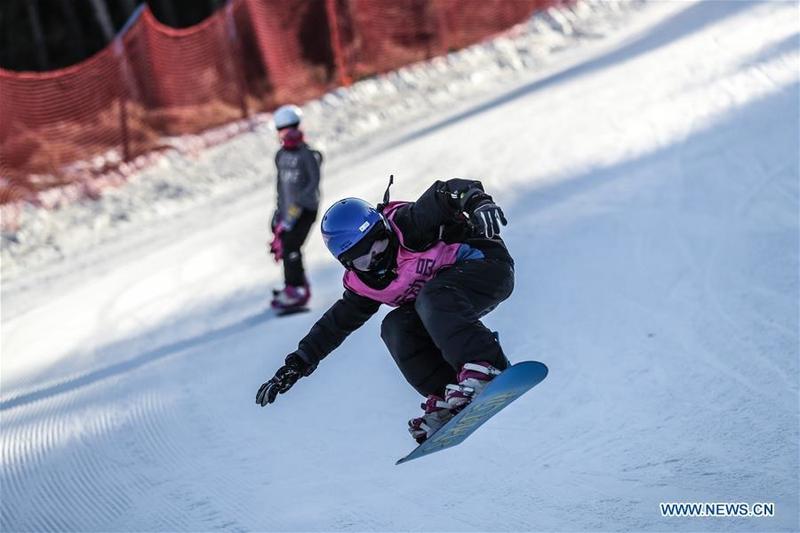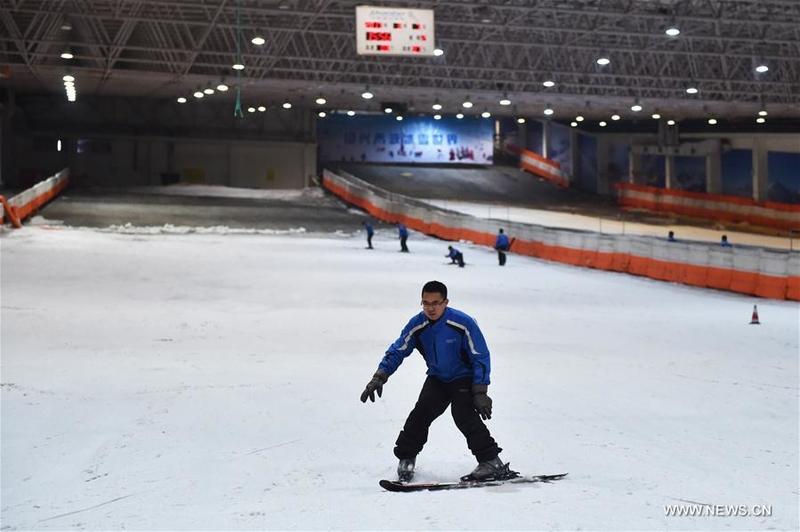 This undated photo shows people skiing at Guangzhou Sunac Snow Park, the largest indoor ski resort in South China. (LI WENFANG / FOR CHINADAILY.COM.CN)
This undated photo shows people skiing at Guangzhou Sunac Snow Park, the largest indoor ski resort in South China. (LI WENFANG / FOR CHINADAILY.COM.CN)
SHAOXING - Xia Zhiyi drove his family 40 kilometres to an indoor ski park in China's eastern Shaoxing city so his 12-year old daughter could practice skiing on a slope of artificial snow.
His family is part of a growing number of Chinese taking interest in the winter sport which analysts say is increasingly seen as a status symbol in China and is being actively promoted by the government ahead of the 2022 Winter Olympics.
China hopes to turn 300 million people into skiers and snowboarders in coming years as it seeks to generate interest in the sport before the 2022 Winter Olympics
The 41-year old said he was preparing his daughter to ski on mountains during a family trip he had booked for this winter.
"You have to book six months in advance to secure a good spot," he added.
China hopes to turn 300 million people into skiers and snowboarders in coming years as it seeks to generate interest in the sport before the 2022 Games and eyes a sector expected to reach 1 trillion yuan (US$149.19 billion) in value by 2025.
ALSO READ: Global firms ready to ride the winter sports wave
The government began putting ski on China's map in 2016, offering discounts on electricity and land usage to some ski parks, after it won a bid in 2015 to host the Winter Olympic Games.
In recent years, Beijing has helped deepen the cooperation between ski parks and schools as it aims to add winter sports to the curriculums of 5,000 schools by 2025.
 A child practices snowboarding on a track during a training session at Shenyang Sport University, in Shenyang, northeast China's Liaoning province, on Jan 23, 2019. (PAN YULONG / XINHUA)
A child practices snowboarding on a track during a training session at Shenyang Sport University, in Shenyang, northeast China's Liaoning province, on Jan 23, 2019. (PAN YULONG / XINHUA)
That would help secure a steady customer base for ski parks such as Shaoxing Qiaobo Ice & Snow World, which has already seen a steady rise in revenues since China won the Olympics bid.
Revenues at Shaoxing Qiaobo surged 20 percent in 2019, its biggest rise since opening 11 years ago, said manager Zhang Di. It is now running at less than 20 percent of its full capacity of 3,000 daily visitors due to the weakened economy and lingering coronavirus concerns.
READ MORE: Winter Olympics heat up ice-snow tourism in north China town
 This photo taken on March 7, 2017 shows a tourist skiing at Qiaobo Ice and Snow World in Hangzhou, east China's Zhejiang province. (HUANG ZONGZHI / XINHUA)
This photo taken on March 7, 2017 shows a tourist skiing at Qiaobo Ice and Snow World in Hangzhou, east China's Zhejiang province. (HUANG ZONGZHI / XINHUA)
Zhang Li, analyst at International Data Consulting (IDC), expects overall revenues at the over 760 snow resorts in China to drop more than 50 percent in 2020 but said at least 25 percent of those should recover more quickly since they are indoor parks and can open all year around.
Back at Shaoxing Qiaobo, manager Zhang was counting on "addicted" children to become loyal customers, adding that the park had signed partnership deals with two neighboring schools.
A 7-year old slowly navigated the snow at the indoor park holding the hands of his coach. His father Li Hao said the boy grew to like snow sports after being introduced to hockey and skating at his school.
"We came because our child is quite fond of snow sports, he can go to an outdoor ski resort when he's older."


